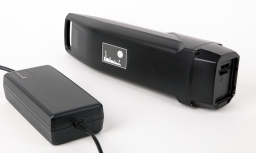Ebike Battery
An ebike battery is a power supply that allows an ebike to be ridden without requiring any human power to be exerted. Lithium-ion (Li-ion) batteries are most common in ebikes, and some ebikes have nickel-metal hydride (NiMH) or lead-acid batteries. These are very popular due to their efficiency, lightweight, and long service life.
The capacity of an ebike battery is given in watt hours (Wh). This tells us how much energy the battery is able to store and discharge to the motor. This means that the larger the capacity, the longer period in which the ebike can run without being charged again. Standard ebike batteries are between 250Wh and a little over 1,000Wh based on the bike model and usage. [1]
Types of Ebike Batteries
- Lithium-Ion Batteries: Probably the most frequently used ones in current ebikes, these batteries possess notable features such as high energy density, reduced weight and great cycle longevity. High-performance models are some of the most common applications of mini vehicles. [2]
- Nickel-Metal Hydride (NiMH) Batteries: However, NiMH batteries were previously used owing to the environmental benefits they have over lead-acid batteries. However, they are heavier and less efficient than other possibilities, such as lithium-ion batteries.
- Lead-Acid Batteries:Lead-acid batteries, which are commonly used in old models or low-priced electric bicycles, are heavy and have low energy conversion efficiency and shorter cycles than lithium-ion batteries. They are gradually being replaced by lighter ones, which consume comparatively lesser amounts of energy. [3]
- Battery Capacity: To reiterate, the watt-hour rating determines the riding time an ebike can offer after a full recharge. The higher the rating, the longer the time. So, with a larger capacity, get a heavier battery, which will also add to the weight of the bike.
- Riding Conditions: This implies that ebike battery depletion largely relies on two factors: the type of terrain and the type of riding style.
- The battery may be depleted if any uphill ride is made, a rough terrain is chosen, or there is a weight to carry.
- Temperature: Temperatures can cause the battery to degrade, but excessive temperatures at either extreme are detrimental to the battery. For example, cold climates adversely affect performance but are noticeably worse, and high temperatures may lead to battery failure.
- Charging Practices: Incorporated current technology has made the ebike battery charge properly so that it can serve for a long duration before being replaced. Periodic full charging and deep discharging decrease its carrying capacity; similarly, charging it more often than necessary or charging it until the battery is at 0% affects the battery’s general capacity. It is suggested that the battery be charged when it is lower, for example, 20-30%, and discharged when it is at full capacity.
How to Extend the Life of an Ebike Battery
To ensure the ebike battery lasts as long as possible, consider the following tips:
- Store in a Cool, Dry Place: Recommended conditions for storage of the battery should not include high temperatures and high humidity levels.
- Charge Regularly: Do not let the battery drain to 0%, and charge it immediately after frequent use.
- Avoid Overcharging: Some of the ebike batteries are equipped with electronic circuits that cut off charges, which in actuality might be damaging to the battery. However, it is still advisable to remove the charger once the battery is fully charged.
- Reduce Load on the Battery: Avoiding unnecessary use of throttle and opting for pedaling also increases the battery durability, and reducing the load that is carried also helps.
Conclusion
Ebike battery is central to the unit and defines how many miles one can cover, the level of boost, and the required charging frequency. Even with an ebike, the capacity, the type of terrain, and temperature all play a role in the performance of the ebike, and its batteries and understanding each can be very helpful. Finally, not only do ebike batteries guarantee a comfortable ride, but they also provide sustainability, making ebikes good for the environment.
Images
Related-topics
- 48v Ebike Battery
- Belt Drive Ebike
- Cargo Ebike
- Class 2 Ebike
- Class 3 Ebike
- Dirt Ebike
- Dual Motor Ebike
- Ebike Car Rack
- Ebike Carrier
- Ebike Frame
- Ebike Helmet
- Ebike Hitch Rack
- Ebike Motor
- Ebike Motorcycle
- Ebike Rack
- Ebike Range
- Ebike Trailer
- Electric Ebike
- Fastest Ebike
- Fat Tire Ebike
- Foldable Ebike
- Folding Ebike
- Full Suspension Ebike
- Kids Ebike
- Lightweight Ebike
- Long Range Ebike
- Mid Drive Ebike
- Mountain eBike
- Offroad eBike
Also See: Ebike Battery
References
- Ufine Battery [ The Ultimate Guide to Ebike Battery ] April 16, 2024
- Electric Bike Report [ The Different Types of E-Bike Batteries ] December 15, 2023
- Great Bike [ Everything about e-bike Batteries ] November 8, 2023
Contributors
Last Modified: July 1, 2025
